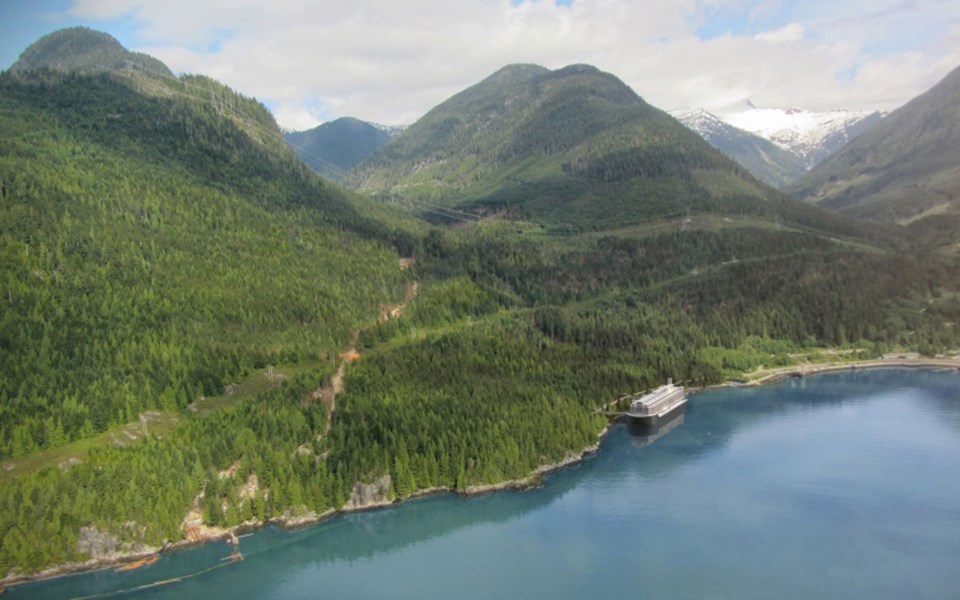The floating worker accommodation for Woodfibre LNG (WLNG) received approval from the Environmental Assessment Office and is still on track to arrive in 2024.
According to the president of WLNG, the accommodation, which is being called the floatel, is currently in the refit stage in Europe but aims to arrive at the natural gas export facility about seven kilometres outside of Squamish on Howe Sound in early 2024. When operational, the floatel should house about 600 workers.
“A floatel proved to be the best option based on findings related to lowest socioeconomic impact to local community, lowest impact on highway and marine traffic and smallest environmental footprint,” said the president, Christine Kennedy, in an emailed statement to The Squamish Chief.
“Using a floatel for workforce accommodation is intended to ensure minimal interaction with the community, while providing safe and comfortable housing for the construction workforce. It’s important to note that any non-local workers will have no access to the community of Squamish, except in the case of a medical emergency requiring treatment beyond the capacity of on-board providers.”
The Environmental Assessment Office (EAO), which is a Crown agency that co-ordinates environmental assessments of projects, recently gave the go-ahead for the facility.
“The Environmental Assessment Office has approved the amendment to the environmental assessment certificate for the Woodfibre LNG Project to allow for a temporary floating worker accommodation, or ‘Floatel,’ as well as its associated mooring, access infrastructure, and onshore drinking-water treatment facility,” reads the EAO’s website about the project published on Nov. 9.
Moreover, the EAO wrote that it worked closely with the Sḵwx̱wú7mesh Úxwumixw (Squamish Nation) to develop a requirement for a gender and cultural safety management plan alongside changes to the community services and infrastructure management plan.
“This is the first time the EAO has required a gender and cultural safety management plan, which will become standard practice and an important consideration for all future projects with large work camps,” said the EAO.
Other stipulations include conducting air quality and noise monitoring by WLNG.
Regarding the gender and cultural safety plan, the amended certificate from the EAO said WLNG must establish proactive measures to deter gender-based violence in the District of Squamish (DOS) and Squamish area by the workers and establish clear reporting and response protocols, including a confidential reporting line to receive complaints.
Sxwixwtn, Wilson Williams, Sḵwx̱wú7mesh Úxwumixw spokesperson and council member said that the Nation's Environmental Assessment Agreements give the Nation "a unique and independent regulatory role over two major projects in our territory, including the WLNG project."
“These agreements are the first legally binding, Indigenous-led assessments of projects in Canada, recognizing our inherent decision-making role on what happens in our lands and waters,” Wilson said in an email to The Squamish Chief.
“This means the projects cannot proceed unless they meet Squamish Nation’s conditions of approval. The Squamish Nation reviewed the floatel application with a particular focus on the safety of Indigenous women, girls and two-spirit individuals in our Community. We then collaborated with our co-regulators at the BC Environmental Assessment Office to ensure WLNG was required to put a comprehensive gender and safety management plan in place.
We look forward to working with the EAO on other aspects of these projects so we can continue to reflect the environmental, cultural and social priorities of our Nation.”
The EAO said the office needs to receive the plan at least 60 days before workers occupy the floatel unless otherwise authorized by the office.
In addition to the plan, the deputy chief executive assessment officer with the EAO, Chris Trumpy, noted in the certificate that WLNG “must establish a committee to engage DOS and its community organizations, no less than once per quarter, and consult with parties identified in this condition, with participation from FortisBC, on issues that impact workforce housing, safety and community services.”
“This must include socio-economic metrics, quarterly reports, and potential cumulative issues arising from concurrent workforce housing interactions between Woodfibre LNG and FortisBC’s projects, and to develop or refine responsive mitigation measures,” he continued.
Trumpy previously wrote to the District about such meetings when responding to concerns from the District about another large infrastructure project in Squamish, the Eagle Mountain – Woodfibre Gas Pipeline (EGP) Project from FortisBC.
The last update provided to council that involved the floatel at WLNG took place on Oct. 17 at a regular business meeting.
At the time, it was anticipated that a temporary use permit application for the floatel would be presented to council as well as a public hearing by the end of 2023, although it was noted that there were upcoming holidays to consider. Since then, council issued a development permit for the form and character of five buildings at WLNG on Nov. 7, which was a non-discretionary item so long as the buildings in question fit the guidelines and regulations for a development permit.
**Please note that this story was updated on Nov. 21 with a comment from Squamish Nation.




